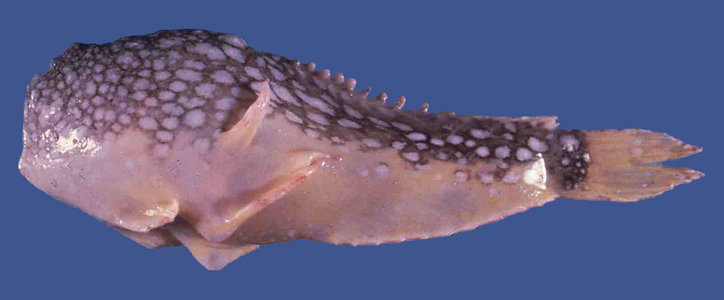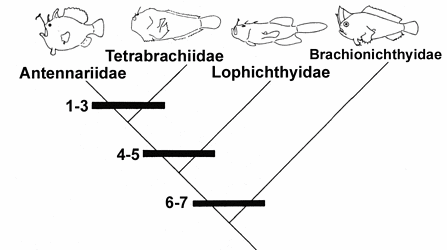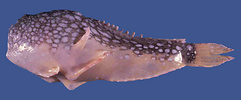Tetrabrachiidae
Tetrabrachium ocellatum
Four-armed frogfish
Theodore W. PietschIntroduction
The Tetrabrachiidae is a monotypic family of lophiiform fishes restricted to shallow (5–55 m) inshore waters around northern Australia, New Guinea, and Indonesia. The only known species, Tetrabrachium ocellatum, has close-set eyes protruding from the dorsal surface of the head and a peculiar webbing between the pectoral fin and the body, and between the pectoral and pelvic fins, characters that reflect a benthic existence in soft substrates such as mud and fine sand.
Characteristics
Diagnosis
Mouth small, opening dorsally, bones of jaws nearly vertical, nearly completely hidden by folds of skin; lower lip lined with small, cutaneous papillae; eyes small, close-set, protruding from dorsal surface of head; anterior half of frontals separate, posterior half meeting on midline; pterosphenoid present; parietals separated by supraocciptial; mesopterygoid absent, ectopterygoid triradiate, T-shaped; dorsal head of quadrate narrow, less than width of metapterygoid; interhyal with a medial, posterolaterally directed process; interopercle flat, broad; pharyngobranchial I present; epibranchial teeth absent; ceratobranchials toothless; toothed portion of ceratobranchial V expanded; hypohyals II and III bifurcated; ossified basibranchials absent; small basihyal present; neural spines of preural centra 12–22 short, spatulate, not interdigitating with proximal radials of soft dorsal fin; epurals absent; three dorsal-fin spines without interconnecting membrane; illicial cavity absent; illicium reduced, without esca, emerging anterior to eyes; second dorsal-fin spine covered with cutaneous filaments, emerging from between eyes; third dorsal-fin spine nearly completely covered with skin of head, distal tip emerging on posterior margin of cranium; illicial pterygiophore and pterygiophore of third dorsal-fin spine with highly compressed, bladelike dorsal expansion, each expansion with a foramen within which lie medially directed prongs of proximal end of respective dorsal-fin spine; soft dorsal-fin rays 16–17; anal-fin rays 11–12; pectoral-fin rays 9, divided into dorsal portion of 4 rays interconnected by membrane, ventral portion of 5 interconnected rays to pectoral-fin lobe; dorsalmost ray of pelvic fin connected by membrane; three pectoral radials; skin naked except for very few microscopic spinules associated with pores of accoustico-lateralis system.
Description
Body strongly compressed, elongate (greatest depth 50% SL); head compressed, short (<32% SL); cranium strongly oblique in position, posterior end of cranium and anterior vertebrae raised forming a prominent convex hump; mouth small, width <16% SL; anterior nostril opening on edge of upper lip, posterior nostril opening approximately half-way between wedge of lip and eye; oral valve present lining both upper and lower jaw; gill opening small, situated just below and behind base of pectoral-fin lobe; no opening behind fourth gill arch; holobranchs present on ventral half of ceratobranchial I, full length of ceratobranchials II and III, ventral half of epibranchial II, and ventral tip of epibranchial III; hemibranchs present on dorsal half of ceratobranchial IV and ventral tip of epibranchial IV; pseudobranch absent; swim bladder absent; ovaries paired.
Pterygiophore of illicium completely covered by skin of head; illicial bone short (<8% SL) and thin, tapering to a point; bases of soft dorsal and anal fins long (>48% and 42% SL, respectively), rays short; dorsal- and anal-fin rays enveloped in membrane; in some specimens (7 of 16 specimens examined) distal tips of first 9 rays of soft dorsal fin free, each terminating in a tight ball of tissue, remaining dorsal rays enveloped in membrane; caudal fin long (>30% SL), rounded.
Teeth small, slender, recurved, and depressible; each premaxilla with a single row of 22–25 teeth, each dentary with approximately 35 teeth; vomerine teeth in two patches, about 25 teeth in each patch; palatine teeth absent; pharyngobranchials II and III and ceratobranchial V toothed.
Color in preservative white on lower half of body to brown on upper half of body, with numerous, small, white spots continuing onto soft dorsal fin, remaining fins white; oral cavity and viscera unpigmented.
Length to 67 mm SL.
Habitat and Distribution
Due to the rarity of this species, specific information on the habitat of Tetrabrachium ocellatum is available for only two specimens. Both were trawled off a bottom of mud, gravel, and shells. A number of other specimens were collected in prawn trawls most likely fished over similar, soft-bottom substrates of mud or sand. This monotypic family is known from 36 specimens collected in shallow water (<55 m) off the western and northern coasts of Australia, the southern coast of Papua, New Guinea, and the south Molucca Islands of Indonesia.
Relationship of Tetrabrachiidae to Other Antennarioidei
The hypothesized relationships of the Antennarioidei as presented by Pietsch (1981) and Pietsch and Grobecker (1987). See below for character states.
The family Brachionichthyidae is classified as the basal sister taxon of a clade including the Lophichthyidae, Tetrabrachiidae, and Antennariidae; these four families forming the lophiiform suborder Antennarioidei (Pietsch, 1981; Pietsch and Grobecker, 1987). Monophyly of the suborder and the relationships within it are supported by a total of seven synapomorphies (see above cladogram):
- Posteromedial process of vomer emerging from ventral surface as a laterally compressed, keel-like structure, its ventral margin (as seen in lateral view) strongly convex;
- Postmaxillary process of premaxilla spatulate;
- Opercle similarly reduced in size;
- Ectopterygoid triradiate, a dorsal process overlapping the medial surface of metapterygoid;
- Proximal end of hypobranchials II and III deeply bifurcate;
- Interhyal with a medial, posterolaterally directed process that makes contact with the respective preopercle;
- Illicial pterygiophore and pterygiophore of third dorsal-fin spine with highly compressed, blade-like dorsal expansions.
References
Pietsch, T. W. 1981. The osteology and relationships of the anglerfish genus Tetrabrachium, with comments on lophiiform classification. U. S. Fish. Bull., 79(3): 387-419.
Pietsch, T. W., and D. B. Grobecker. 1987. Frogfishes of the World: Systematics, Zoogeography, and Behavioral Ecology. Stanford University Press, Stanford, xxii , 420 pp.
About This Page
Theodore W. Pietsch

University of Washington, Seattle, Washington, USA
Correspondence regarding this page should be directed to Theodore W. Pietsch at and Christopher P. Kenaley at
Page copyright © 2005 Theodore W. Pietsch
 Page: Tree of Life
Tetrabrachiidae. Tetrabrachium ocellatum. Four-armed frogfish.
Authored by
Theodore W. Pietsch.
The TEXT of this page is licensed under the
Creative Commons Attribution-NonCommercial License - Version 3.0. Note that images and other media
featured on this page are each governed by their own license, and they may or may not be available
for reuse. Click on an image or a media link to access the media data window, which provides the
relevant licensing information. For the general terms and conditions of ToL material reuse and
redistribution, please see the Tree of Life Copyright
Policies.
Page: Tree of Life
Tetrabrachiidae. Tetrabrachium ocellatum. Four-armed frogfish.
Authored by
Theodore W. Pietsch.
The TEXT of this page is licensed under the
Creative Commons Attribution-NonCommercial License - Version 3.0. Note that images and other media
featured on this page are each governed by their own license, and they may or may not be available
for reuse. Click on an image or a media link to access the media data window, which provides the
relevant licensing information. For the general terms and conditions of ToL material reuse and
redistribution, please see the Tree of Life Copyright
Policies.
- First online 28 October 2005
Citing this page:
Pietsch, Theodore W. 2005. Tetrabrachiidae. Tetrabrachium ocellatum. Four-armed frogfish. Version 28 October 2005 (under construction). http://tolweb.org/Tetrabrachium_ocellatum/21994/2005.10.28 in The Tree of Life Web Project, http://tolweb.org/










 Go to quick links
Go to quick search
Go to navigation for this section of the ToL site
Go to detailed links for the ToL site
Go to quick links
Go to quick search
Go to navigation for this section of the ToL site
Go to detailed links for the ToL site